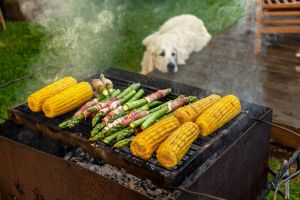Summer is the perfect time to get out and enjoy those warm, sunny days with your furry friend. Unfortunately, this time of year can be hazardous for pets. If you are not careful, your dog or cat could experience serious injuries, illnesses, or worse. As veterinarians, we want you and your pet to enjoy the rest of a healthy, fun-filled summer, so we're sharing information about some of the most common summertime pet hazards below.

1. High Temperatures and Humidity
Let’s start with the most obvious hazard — heat. When the temperature soars, companion animals risk heat exhaustion and heatstroke. And the risk is especially serious when the humidity is high, too. If you think it's too hot outside for you, it's way too hot for your pet.
Limit your pet's activity and keep them indoors as much as possible during hot, humid weather. If they go outside, ensure they have access to clean, cool water and plenty of shade. Remember: never leave your pet in a parked car! Even on a reasonably cool 70-degree day, the temperature inside a vehicle can reach 100 degrees in less than 30 minutes.
2. Mosquitos
It's safe to say no one likes mosquitos, but these notorious pests are more than just a nuisance. They carry heartworm and can infect dogs and cats with a single bite. Plus, mosquito-related illnesses are becoming more prevalent in the United States. Protect your pet from heartworm (and other diseases transmitted by mosquitoes and other insects) by keeping them on an effective flea, tick, and heartworm medication year-round. If mosquitos are a major problem in your area, consider having your lawn sprayed.

3. Plants
If your four-legged best friend likes spending time in the garden, ensure you're not growing anything that could harm them. Many indoor and outdoor plants are hazardous to pets.
Some of the most hazardous plants for pets include:
- Lilies
- Rhododendrons
- Tulips
- Sago
- Palm
- Foxglove
- Azaleas
- Oleander
There are many, many others. Check out the ASPCA's list of toxic plants to learn more.
4. Sun
You already know spending too much time in the sun increases your risk of cancer. But did you know that animals' skin is also sensitive to the sun? Like humans, they can get sunburns and develop skin cancer. This problem is especially dangerous for white dogs and cats and those with sparse coats, but any pet who spends a lot of time in the sun is at risk.
In addition to ensuring your pet has shady areas to escape from the sun, apply sunblock to areas with little fur, like the ear tips, bridge of the nose, and belly/groin. There are products formulated specifically for pets that are safe if ingested. Don’t use regular sunscreen made for humans as it could make your pet sick.

5. Barbecues and Picnics
Summer is the perfect time to enjoy tasty treats in the backyard. Unfortunately, many of your favorite foods could be hazardous to pets. Despite common misconceptions, bones aren't a safe treat for dogs, so keep those rib bones out of reach! And things like corn cobs and watermelon rinds can cause intestinal blockages. Even grapes, which are in many summertime desserts and snacks, are unsafe. They’re highly toxic to animals, so even if your pet eats just one, it's crucial to contact a veterinarian immediately.
Wooden BBQ skewers are also very dangerous if ingested by pets. They are sharp enough to lacerate the stomach or intestine.
6. Water
Some pups love splashing around in the water. Others don't. Not all dogs can swim, so you should never force an apprehensive dog into the water. If your canine companion can't swim, they'll likely panic and could drown. Protect your pet by ensuring they wear a lifejacket when near water and that any fencing around your pool is in working order.

7. Sand
There’s nothing better than enjoying a beach day with your pet. Unfortunately, even sand can be hazardous. It could burn your pet's paw pads on hot, sunny days. As a rule of thumb, if it's too hot for you to walk barefoot comfortably, it's too hot for your pet.
In addition, consuming too much sand can lead to bowel obstruction. Rinse toys with fresh water and ensure they aren't full of sand. Keep an eye on your dog to make sure they aren't snacking on the sand, too. Dogs can also get sand stuck under their eyelids or attached to their cornea, leading to an ulcer.
8. Pesticides and Fertilizer
The pesticides and fertilizers that make your lawn and garden look great could be deadly to your pets. Many of these products are toxic, so be careful when using them in your home and on your property.
If you have any reason to think your furry friend has ingested a pesticide or fertilizer, consider this an emergency and contact a veterinarian and the Pet Poison Helpline immediately. In these situations, time is of the essence. Don’t wait until your pet starts showing symptoms to seek help.
Closing Thoughts
Don’t let hazards get in the way of you and your pet enjoying an amazing, fun-filled summer. Be mindful of the dangers above, and seek veterinary care immediately if you think there might be a problem. If your furry friend needs help, give us a call!

